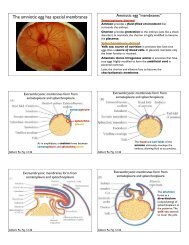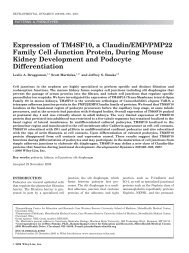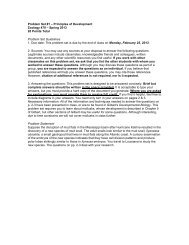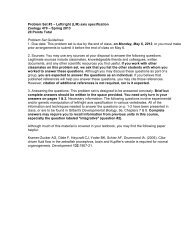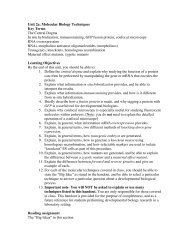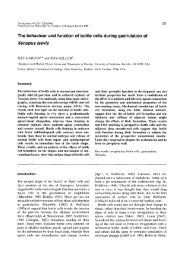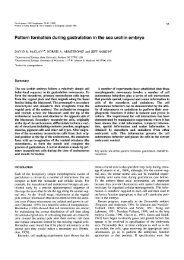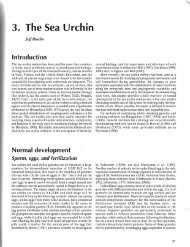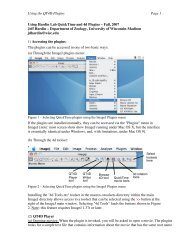WOC 6e Guide to Microscopy
WOC 6e Guide to Microscopy
WOC 6e Guide to Microscopy
You also want an ePaper? Increase the reach of your titles
YUMPU automatically turns print PDFs into web optimized ePapers that Google loves.
The optical path through a compound microscope, illustrated<br />
in Figure A-5b, begins with a source of illumination, usually a<br />
light source located in the base of the instrument. The light<br />
rays from the source first pass through condenser lenses,<br />
which direct the light <strong>to</strong>ward a specimen mounted on a glass<br />
slide and positioned on the stage of the microscope. The<br />
objective lens, located immediately above the specimen, is<br />
responsible for forming the primary image. Most compound<br />
microscopes have several objective lenses of differing magnifications<br />
mounted on a rotatable turret.<br />
The primary image is further enlarged by the ocular<br />
lens, or eyepiece. In some microscopes, an intermediate lens<br />
is positioned between the objective and ocular lenses <strong>to</strong><br />
accomplish still further enlargement. You can calculate the<br />
overall magnification of the image by multiplying the enlarging<br />
powers of the objective lens, the ocular lens, and the<br />
intermediate lens (if present). Thus, a microscope with a 10µ<br />
objective lens, a 2.5µ intermediate lens, and a 10µ ocular lens<br />
will magnify a specimen 250-fold.<br />
The elements of the microscope described so far<br />
create a basic form of light microscopy called brightfield<br />
microscopy. Compared with other microscopes, the brightfield<br />
microscope is inexpensive and simple <strong>to</strong> align and use.<br />
However, the only specimens that can be seen directly by<br />
brightfield microscopy are those that possess color or have<br />
some other property that affects the amount of light that<br />
passes through. Many biological specimens lack these characteristics<br />
and must therefore be stained with dyes or examined<br />
with specialized types of light microscopes. These special<br />
microscopes have various advantages that make them especially<br />
well suited for visualizing specific types of specimens.<br />
These include phase-contrast microscopy, differential interference<br />
contrast microscopy, fluorescence microscopy, and<br />
confocal microscopy. We will look at these and several other<br />
important techniques in the following sections.<br />
PHASE-CONTRAST MICROSCOPY DETECTS<br />
DIFFERENCES IN REFRACTIVE INDEX AND THICKNESS<br />
As we will describe in more detail later, cells are often killed,<br />
sliced in<strong>to</strong> thin sections, and stained before being examined<br />
by brightfield microscopy. While such procedures are useful<br />
for visualizing the details of a cell’s internal architecture, little<br />
can be learned about the dynamic aspects of cell behavior by<br />
examining cells that have been killed, sliced, and stained.<br />
Therefore, a variety of techniques have been developed for<br />
using light microscopy <strong>to</strong> observe cells that are intact and, in<br />
many cases, still living. One such technique, phase-contrast<br />
microscopy, improves contrast without sectioning and staining<br />
by exploiting differences in the thickness and refractive<br />
index of various regions of the cells being examined. To<br />
understand the basis of phase-contrast microscopy, we must<br />
first recognize that a beam of light is made up of many individual<br />
rays of light. As the rays pass from the light source<br />
through the specimen, their velocity may be affected by the<br />
physical properties of the specimen. Usually, the velocity of<br />
the rays is slowed down <strong>to</strong> varying extents by different<br />
regions of the specimen, resulting in a change in phase relative<br />
<strong>to</strong> light waves that have not passed through the object.<br />
A-6 Appendix Principles and Techniques of <strong>Microscopy</strong><br />
(Light waves are said <strong>to</strong> be traveling in phase when the crests<br />
and troughs of the waves match each other.)<br />
Although the human eye cannot detect such phase<br />
changes directly, the phase-contrast microscope overcomes<br />
this problem by converting phase differences in<strong>to</strong> alterations<br />
in brightness. This conversion is accomplished using a phase<br />
plate (Figure A-6), which is an optical material inserted in<strong>to</strong><br />
the light path above the objective lens <strong>to</strong> bring the direct or<br />
undiffracted rays in<strong>to</strong> phase with those that have been diffracted<br />
by the specimen. The resulting pattern of wavelengths<br />
intensifies the image, producing an image with highly contrasting<br />
bright and dark areas against an evenly illuminated<br />
background (Figure A-7). As a result, internal structures of<br />
cells are often better visualized by phase-contrast microscopy<br />
than with brightfield optics.<br />
This approach <strong>to</strong> light microscopy is particularly useful<br />
for examining living, unstained specimens because biological<br />
materials almost inevitably diffract light. Phase-contrast<br />
microscopy is widely used in microbiology and tissue culture<br />
research <strong>to</strong> detect bacteria, cellular organelles, and other<br />
small entities in living specimens.<br />
Light source<br />
Image plane<br />
Phase<br />
plate<br />
Diffracted light<br />
(phase altered<br />
by specimen)<br />
Objective lens<br />
Direct light<br />
(phase unaltered<br />
by specimen)<br />
Condenser lens<br />
Annular<br />
diaphragm<br />
Figure A-6 Optics of the Phase-Contrast Microscope. The configuration<br />
of the optical elements and the paths of light rays through<br />
the phase-contrast microscope. Pink lines represent light diffracted<br />
by the specimen, and black lines represent direct light.



